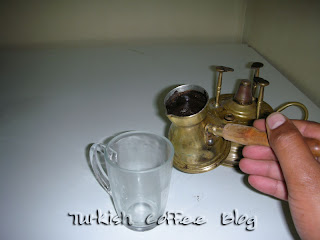It's really exciting to see how Turkish coffee is prepared in different parts of the world. If you want to share your own Turkish coffee experience please send an email.
Turkish Coffee in Egypt
This guide is for brewing Turkish coffee using (cebertaiyah) pictured below, the method is not very different from the guide posted by Mahir here for brewing coffee using a stove; it’s just a different heating device.
This device, cebertaiyah, is made from copper, uses red alcohol (ceberto) as a source of the flame, the main idea behind it is that the flame is weak and slow in heating the water, which in turn makes brewing the coffee take longer time than brewing on a stove, so it makes the coffee brewed taste stronger.
I don’t know the history of this device but I know it’s been around before the introduction of stoves, it comes in different shapes and styles and is also used to make tea, it’s starting to disappear from the market though, most people consider it a relic, or a decoration item because most people now use stoves or machines to brew their coffee.
Now that you have a source of heat you need a pot (“canaka" in Arabic and "cezve" in Turkish) pictured below; it is also made from copper for uniform heat transfer and equipped with a wooden handle for ease of use.
Next you need the coffee itself, which comes in a different variety, Turkish coffee beans should be ground to the finest level possible.
There are the light roasted beans, the medium roasted and the dark roasted beans “my favorite”. Dark coffee has a bit of a sting to it, so beware, it’s not suitable to people newly introduced to the world of Turkish coffee.
Now, you add the sugar (if you want sugar), the coffee, then add the water.
Tip: I found that using cold water has better results than using room temperature water; maybe this is due to the fact that cold water takes longer to brew thus giving the mixture a longer time to mix.
With regards to sugar, there are 3 (or five) types of coffee, the no sugar coffee (sadah or merra), the medium sugar coffee (mazbot), and the lots of sugar coffee (zyadah).
For the amount to coffee and sugar, I encourage the new comers to experiment, you can start with two teaspoons of coffee and one small teaspoon of sugar, this way the coffee is not bitter.
After you add the mixture, and before putting it on fire, give it a good stir.
Now here is another tip, and if you will take anything from this article, let it be this, always stir the mixture while it’s on the flame, it doesn’t matter what heating device you’re using, make sure that you give your coffee at least three good stirs while it’s brewing.
You wait until your coffee is near the boiling point and then remove it, you can leave the coffee to cool and bring your coffee to the point boiling several times it you want, but once is enough.
After you remove the pot from the cebertaiyah you replace the flame cap, it’s a bit tricky, and you do it from the side in a slide motion.
Now pour your coffee and enjoy.
This article was written and also the photos were taken by Ahmed from Egypt.












1 comment:
Hey there!
I've bumped onto your blog about coffee and I must say it's terrific! My warmest compliments!
What about adding some colour in it by bonding coffee with some artistic event?
You know, I've heard of an international digital arts competition called "Anthares Coffee Prize", which sounds to be pretty interesting!
I've already posted something concerning the contest on my own blog and it seems successful !
Greets
Jess
Post a Comment